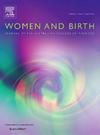维多利亚州COVID-19大流行期间的次优护理因素和死产:一项关于死产和产科和儿科死亡率和发病率咨询委员会病例审查的全州联系研究。
IF 4.4
2区 医学
Q1 NURSING
引用次数: 0
摘要
问题:COVID-19大流行影响了全球围产期结局,一些地区报告死产增加。背景:澳大利亚墨尔本经历了最长、最严格的疫情封锁之一。目的:比较大流行前和期间妊娠20周单胎妊娠bb0 的死产率,并检查次优护理因素的差异。方法:提取维多利亚州2018年1月至2021年12月≥ 20周的单胎分娩数据,并将其与产科和儿科死亡率和发病率咨询委员会数据库中的死胎相关联。在大流行前时期(2018- 2019年)和大流行年份(2020年、2021年)之间对患者特征、妊娠结局和次优护理因素进行了统计比较。结果:在302528例单胎分娩中,有2244例死产。死产率在大流行第一年(0.81 %)高于大流行前年份(0.73 %)和大流行第二年(0.70 %)(p = 0.04)。没有死产直接归因于母体感染COVID-19。各时期护理因素不理想的死产比例相似(p > 0.05)。作为一个促成因素,“参与护理的障碍”的频率增加了(p )讨论:在大流行期间观察到死产率的大幅波动,在2020年暂时上升。获得保健的障碍是一个显著因素。结论:将以妇女为中心的护理纳入解决结构性不平等问题,对于支持家庭和建立公正的卫生系统至关重要。本文章由计算机程序翻译,如有差异,请以英文原文为准。
Suboptimal care factors and stillbirths during the COVID-19 pandemic in Victoria: A state-wide linkage study of stillbirths and Consultative Council on Obstetric and Paediatric Mortality and Morbidity case reviews
Problem
The COVID-19 pandemic affected perinatal outcomes globally, with some regions reporting an increase in stillbirths.
Background
Melbourne, Australia, experienced one of the longest and most stringent pandemic lockdowns.
Aim
To compare stillbirth rates for singleton pregnancies > 20 weeks’ gestation before and during the pandemic and examine differences in suboptimal care factors.
Methods
January 2018 to December 2021 data on singleton births ≥ 20 weeks in Victoria were extracted and linked to stillbirths in the Consultative Council on Obstetric and Paediatric Mortality and Morbidity database. Statistical comparisons of patient characteristics, pregnancy outcomes, and suboptimal care factors were performed between the pre-pandemic period (2018–19) and the pandemic years (2020, 2021).
Results
Among 302,528 singleton births, 2244 stillbirths were recorded. The stillbirth rate was higher in the first pandemic year (0.81 %) compared with pre-pandemic years (0.73 %) and the second pandemic year (0.70 %) (p = 0.04). No stillbirths were directly attributable to maternal COVID-19 infection. The proportion of stillbirths with suboptimal care factors was similar across periods (p > 0.05). 'Barriers to engaging care' increased in frequency as a contributing factor (p < 0.001). 'Organizational factors' were more common in 2020 (p < 0.001), while suboptimal care related to healthcare personnel was less common in 2021 (p < 0.001). Disadvantaged and non-Australian-born women were more likely to experience suboptimal care.
Discussion
Significant fluctuations in stillbirth rates were observed during the pandemic, with a temporary rise in 2020. Barriers to accessing care were a notable factor.
Conclusion
Embedding woman-centred care to address structural inequities is essential for supporting families and creating a just health system.
求助全文
通过发布文献求助,成功后即可免费获取论文全文。
去求助
来源期刊

Women and Birth
NURSING-OBSTETRICS & GYNECOLOGY
CiteScore
7.20
自引率
13.20%
发文量
371
审稿时长
27 days
期刊介绍:
Women and Birth is the official journal of the Australian College of Midwives (ACM). It is a midwifery journal that publishes on all matters that affect women and birth, from pre-conceptual counselling, through pregnancy, birth, and the first six weeks postnatal. All papers accepted will draw from and contribute to the relevant contemporary research, policy and/or theoretical literature. We seek research papers, quality assurances papers (with ethical approval) discussion papers, clinical practice papers, case studies and original literature reviews.
Our women-centred focus is inclusive of the family, fetus and newborn, both well and sick, and covers both healthy and complex pregnancies and births. The journal seeks papers that take a woman-centred focus on maternity services, epidemiology, primary health care, reproductive psycho/physiology, midwifery practice, theory, research, education, management and leadership. We also seek relevant papers on maternal mental health and neonatal well-being, natural and complementary therapies, local, national and international policy, management, politics, economics and societal and cultural issues as they affect childbearing women and their families. Topics may include, where appropriate, neonatal care, child and family health, women’s health, related to pregnancy, birth and the postpartum, including lactation. Interprofessional papers relevant to midwifery are welcome. Articles are double blind peer-reviewed, primarily by experts in the field of the submitted work.
 求助内容:
求助内容: 应助结果提醒方式:
应助结果提醒方式:


